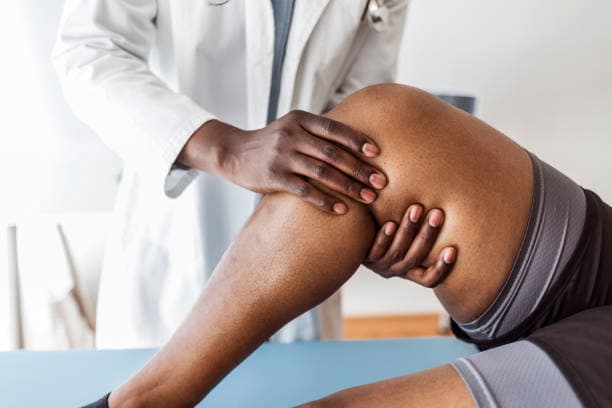
Knees are complex joints involving the synchronized function of multiple ligaments and tendons. Given how often we use them, knee injuries are among the most common reasons to visit an orthopedic surgeon.
Knee strains can occur from overuse or a sudden impact/twisting force. This article reviews the concept of a knee strain and how orthopedic surgeons typically approach them, including causes, treatment methods, prevention tips, and related complications.
What is a Knee Strain?
The term knee strain is a generic description for an injury to a tendon structure in the knee. Tendons are the sinewy fibers which attach muscle to bone, transmitting the contracting force of the muscle to the bone and therefore resulting in movement/force. The tendons most commonly injured are the patellar tendon and quadriceps tendon. A knee strain is basically some level of damage or inflammation of a knee tendon. At a minimum the muscle-tendon unit is painful and swollen. In the worst case a tendon may be completely ruptured.
A knee sprain by contrast describes an injury to the ligaments in the knee. The ligaments of the knee are rope-like structures which attach bone to bone and keep the bones in the correct position during function/movement. The most commonly injured knee ligaments are the MCL (medial collateral ligament) followed by the ACL (anterior cruciate ligament).
How Does a Knee Strain Occur?
A knee strain of a tendon can occur from repetitive overuse such as long-distance running or other similar sports. It can also occur suddenly such as an abrupt stopping maneuver, a direct contusion, or during an explosive motion like jumping or kicking a ball. Improper stretching or lack of flexibility increases the risk for a knee strain. Common sports causing knee strains include football, basketball, soccer, volleyball, and martial arts.
Symptoms of Knee Strain
- Pain in or around the knee
- Swelling around or in the knee
- Tenderness near the knee joint
- Decreased range of motion in the knee
- The intensity of pain increases with bending, extending or contracting the knee muscles
- Pain when walking, running, or participating in sports activities
Diagnosis of Knee Strain
Healthcare providers usually diagnose knee strains based on patient history, physical examination, and occasionally diagnostic imaging studies. X-rays will only show bone and therefore an MRI is most often ordered if history and physical exam are inconclusive.
Patient History
A patient’s medical history is critical in diagnosing a knee strain. Your healthcare provider will ask you questions regarding your symptoms, including a description of your symptoms, when you first experience symptoms, and how frequently your symptoms are. Often information about changes in activities or training protocols are critical to making the diagnosis. Training start date, intensity, recent increases, frequency, and even changes such as running routes or different shoes may all be helpful.
Medical Examination
Your healthcare provider will examine your knee and surrounding area to check for abnormalities such as swelling, tenderness, reduced mobility, warmth, and redness of the knee joint. Focal tenderness at the bottom of the knee cap (patella) can indicate patellar tendonitis. If the quadriceps or patellar tendons are ruptured a palpable gap is often present and easily felt during exam. Additionally inability to actively straighten the knee will be present.
Diagnostic Imaging Studies
Diagnostic imaging studies such as X-rays, MRIs, and CT scans may be used to evaluate the knee. X-rays demonstrate bone anatomy and can show fractures or evidence of arthritis. CT scans are basically 3-dimensional X-ray images which give more detailed bone anatomy as well as some ability to visualize the soft tissues such as muscles, bones, and tendons. MRI’s are by far the best for visualizing tendons in the knee and to confirm the diagnosis of a knee strain. T
Treatment for Knee Strain
Rest
Rest is the first step in treating a knee strain. Resting can mean non-weightbearing with the use of crutches or simply doing less of certain exercises. In either case the point is to give the body time to repair itself before submitting it to more potentially damaging force.
Ice
Applying ice packs to your knee immediately after a strain can reduce swelling, pain, and inflammation. -Compression: Compressing your knee with an elastic wrap can help reduce swelling.
Elevation
When your knee is injured it may have significant swelling. This extra fluid will be held in your leg by gravity and can make recovery take longer. Thus, lying down with your leg raised above your heart level can significantly reduce the swelling by allowing gravity to help pull the extra fluid out of your extremity.
Stretching
Stretching the muscles and tendons around your knee before activity as well as afterwards can help prevent injury. It can also be helpful after the first 48 hours of the injury to relieve the pain and improve the range of motion.
Knee Brace
A knee brace can protect your knee from further injury and support your knee joint after a knee strain.
Recovery from Knee Strain
- The recovery period for a knee strain is different for each individual based on the severity of the strain.
- Mild knee strains usually take 1-2 weeks to recover, while moderate knee strains can take 3-6 weeks. The most severe knee strains commonly take 3 months to fully heal.
- A knee strain will heal faster if the person who hurts it does what the doctor tells them to do, stays away from more stress, and exercises the knee.
Prevention Tips for Strained Knee
- Warm up before participating in sports activities.
- Stretch your muscles before participating in sports activities.
- Wear appropriate sports gear, such as knee pads and knee braces.
- Avoid participating in sports if you have a knee injury.
- When starting a new sport or training regimen begin gradually and slowly increase over time to allow your body to acclimate
- Whenever increasing a training regimen (such as training for a marathon) be sure to do so safely with measured increases in frequency, intensity, and duration.
- If you begin to develop symptoms of knee strain listen to your body and take action to help it heal before it gets worse
- Consider consulting a sports physical therapist before participating in sports activities.
- Visit your healthcare provider immediately if you are suffering from a knee strain.
- Stay hydrated and eat a healthy diet.
- If you are overweight, diet and safely exercise to take excess load off your joints
- Maintain a healthy lifestyle.
Schedule an Appointment with an Orthopedic Specialist at Austin Orthopedic Institute
If you are experiencing any of the symptoms of knee strain, immediately schedule an appointment with an orthopedic specialist at Austin Orthopedic Institute. An orthopedic specialist can confirm the injury, diagnose the condition, and provide appropriate treatment options.
A knee strain can cause long-term damage if left untreated. Visiting your healthcare provider as soon as you notice any signs or symptoms of a knee injury can help reduce the risk of permanent knee damage.
Our team of qualified orthopedic doctors and nurses at Austin Orthopedic Institute are trained to diagnose and treat various orthopedic conditions, including knee injuries. With our state-of-the-art facilities and highly trained doctors, we strive to give our patients the best orthopedic care in the world.
Conclusion
Knee strains are common injuries that can happen to anybody who is active, and especially to athletes and weekend warriors. The best way to prevent knee strains is to warm up before activity, stretch, wear proper gear, and take recovery time seriously. If you have had a knee strain, you should follow your doctor’s instructions for treatment to get better as quickly as possible.


